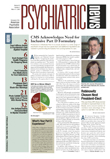How many Americans suffer from symptoms of psychiatric disorders in a year? How many people have psychiatric disorders whose symptoms are serious and disabling? What proportion of these people receive adequate treatment? These and other critical questions for the practice of psychiatry have been addressed in an elaborate and far-reaching study in the “National Comorbidity Survey Replication” conducted by Ron Kessler and colleagues and published in a series of three papers last June in the Archives of General Psychiatry.
This study involved detailed interviews with nearly 9,300 randomly chosen American adults, representative of persons in the general U.S. population, between February 2001 and April 2003. The results indicated that 26 percent of respondents reported having symptoms sufficient for diagnosing a mental disorder in the previous 12 months. Not surprisingly, prevalence estimates were highest for anxiety disorders at 18 percent, and then mood disorders at nearly 10 percent (Psychiatric News, July 15, 2005).
These rates of disorder are consistent with the rates found in the previous survey a decade ago. In the recent study period, as there have been no“ cures” developed for psychiatric disorders, the lack of change in basic prevalence is not surprising. However, it is important and desirable to be able to document a decrease in disability and the burden of disease as our psychiatric treatment continues to improve. I believe many patients are“ better, but not well” as Gerald Klerman, M.D., put it.
In terms of the severity of psychiatric symptoms, most of the respondents identified as having a psychiatric disorder had symptoms that were considered to be in the mild (41 percent of disorders) or moderate (37 percent of disorders) range, while fewer persons had symptoms that were considered to be in the serious range (22 percent of disorders and 6 percent of the total population sample).
The findings about treatment are most illuminating. Of the people identified as having a psychiatric disorder in the past 12 months, close to 60 percent had not received any treatment for their disorder. Among those who sought treatment (approximately 40 percent), close to one-third did so with unproven therapies, such as dietary supplements or acupuncture. Of those who sought traditional care for their psychiatric problems, the largest number was treated by general medical providers, not psychiatric or mental health specialists. In fact, psychiatrists treated only 12 percent of cases identified as having a psychiatric disorder.
The proportion of the population treated for mental illness over a 12-month period, some of whom did not meet the threshold for a psychiatric diagnosis, has grown to 17 percent from 13 percent a decade ago. This expansion was mainly in the general medical sector, with more primary care physicians providing psychiatric services and psychiatric medications than in the past.
Most distressing to me was the general inadequate level of care that persons received for their psychiatric disorders. Only 13 percent seen for mental health problems by general medical providers received minimally adequate care (defined as receiving either at least two months of an appropriate medication for a focal disorder plus four visits to the physician or with a health care or human services professional for psychotherapy lasting an average of 30 minutes a session). The care was better when provided by psychiatrists; but only 48 percent of those who went to psychiatrists received care that met minimal standards.
These minimally adequate treatment standards set at levels consistent with general levels of treatment guidelines do not answer the question, What are the results of these treatments? More attention is needed to assess treatment outcome in terms of both symptoms as well as functional abilities in the everyday lives of our patients as we make the case for more resources to provide these treatments.
Another important issue this study investigated is the age of onset of psychiatric disorders and the delay in seeking help or treatment. Half of those identified as having a psychiatric disorder reported showing signs of illness by age 14; three-quarters reported showing signs by age 24. Delays for treatment ranged from an average of nine to 23 years for anxiety disorders and six to eight years for mood disorders.
The study raises many questions and issues about the nature of psychiatric disorders and the role of psychiatrists. Does our DSM nosology have too low a threshold in selecting symptoms of mental disorders? Many of these disorders may be self-limiting and mild in response to life stresses. As noted by Dr. Kessler in a recent NPR interview, how much credibility does our diagnostic system lose by attaching a psychiatric diagnosis to these relatively mild and self-limiting problems? Should all people who meet criteria for a disorder receive psychiatric treatment? How do we decide which ones should receive treatment and what kind? Who and how many should be seen by psychiatrists for treatment? Most important for psychiatry, if only a small minority of persons with a serious psychiatric disorder receives care that meets even basic treatment standards, what are the implications for our profession? What can we do to address this problem?
We need to have state-of-the-art performance measures for assessing individual clinical care in psychiatry. All the rhetoric around“ evidence-based medicine” aside, without such, we do not know how well we are doing for our patients.
It is clear that there is an unmet need for treatment. There are far too few psychiatrists to meet that need. Barriers to care remain high. Continued improvements in psychiatric treatment need to translate to better outcomes. Better outcomes will enhance our case for nondiscriminatory insurance coverage. Let's hope that in another 10 years when this study is once again replicated, we will have made significant progress on all of these fronts.▪

